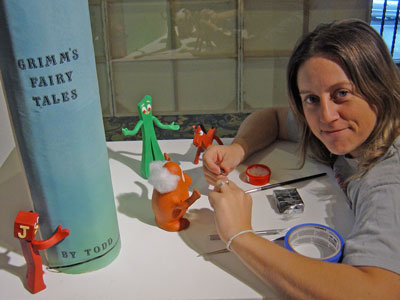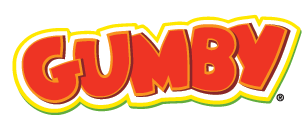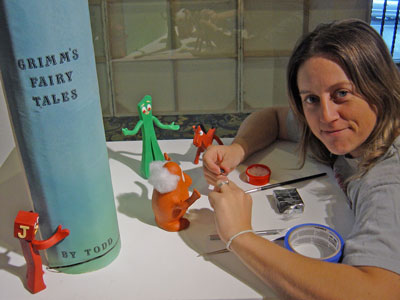We caught up with Gumby puppet maker Nicole LaPointe-McKay to get the inside scoop on making puppets as a profession. Part One of our interview follows, and Part Two will appear in a future blog post, so stayed tuned; you’ll want to read the full story.
 GC: Welcome Nicole. Thank you for taking time to join us at Gumby World today to tell us more about yourself and your experiences as a puppet maker.
GC: Welcome Nicole. Thank you for taking time to join us at Gumby World today to tell us more about yourself and your experiences as a puppet maker.
NLM: I’m happy to be here. I appreciate the opportunity.
GC: How did you become interested in being a puppet maker?
NLM: I’ve been interested in puppets since I was a kid. I was obsessed with the Muppet Show and stop animation programs. I watched Gumby on TV with my little brother. My mother would craft puppets for me to use in plays that I made up. I put on shows with hand puppets, my favorite monkey puppet, and a few marionettes. I always volunteered to get up in front of people to perform and lead others, such as the Girl Scouts, in plays. I was a thespian in high school, and it seemed natural that I would go on to study theater in college.
GC: How did you get involved with Gumby?
NLM: After college and having gained a few years of experience in puppet making, set design and animation, I applied to a posting on AWN.com (Animation World Network), not knowing what the studio was. I didn’t get that particular job, since it had already been filled, but I kept in touch with the studio—Clokey Productions. When studio producer Joe Clokey had an opening for a set designer, he called me. I worked on the Gumby Namco game commercial and have been with Gumby ever since. You can see some production photos here: (http://www.gumbykevinudydigital.com/gumbys-studio/)
GC: What kinds of puppets do you make?
NLM: I’m trained to work with just about any material and style of puppet. In my studies I was exposed to puppets from around the world and different time periods. Some of my favorites were the Japanese bunraku, the French Guinol and the Italian Commedia dell’Arte. Currently I fashion a lot of clay puppets for stop motion. I do have some personal projects in the works that involve hand-rod, big-mouth puppets (like the Muppets-type puppets.) I’m doing some new clay animation, too.
GC: How do you make a Gumby puppet?
NLM: Gumby is made of mostly Van Aken clay—a secret recipe! I whip up a batch following his unique recipe, mix, and boil it down in a double boiler to a unified color and the right consistency. I prep the silicone/stone mold with a floating armature. This is Gumby’s skeleton. I then pour the mixture into the mold and let it cool. Sometimes I chill it in the fridge to speed the process. Next, I pop him out of the mold and clean him up by trimming the seams and patching the bubble marks. Gumby gets an oil massage to make him smooth. I then drop a faceplate on him to mark where the features will go. Finally, I add the delicate clay features of his face.
GC: How many Gumby puppets does it take to make a Gumby TV episode?
NLM: More than you would think. The number of puppets needed really depends upon the storyline and type of morphing and movement that the puppet does. When Gumby morphs and changes shape, he needs to be replaced after every few seconds of animation, because the clay loses its shape. One minute of animation can require 20 Gumbys, sometimes more. The lights can also melt the clay, requiring a change of puppets. Because we go through so many puppets, it’s critical that they are all identical and made to the same specifications.
GC: You were involved in the Gumby Google doodle that appeared on October 12, 2011 to honor Art Clokey’s 90th birthday. Tell us about that.
NLM: It was a collaborative effort, involving a small subset of the Clokey Productions’ crew. We worked long distance—by phone, Skype and email. With the short deadline, I made puppets non-stop for a week before the animator could do his part. We used 3-6 puppets of each character for about 4-6 seconds of animation per character. The individual segments of animation were then sent to Google, where their programming team integrated them into their home page. It was exciting to see the characters come to life and move with the click of a mouse. The interaction was really fun! I think this was the first clay animation doodle that Google has used. The doodle was online around the world, so I hope that it inspired a renewed interest in clay animation. You can view it live and interact with it here: http://www.gumbygoogle.co.cc/
GC: What do you do for fun?
NLM: I’m always brainstorming and designing puppet shows and animations based on the interests of little kids that I know. I watch a lot of cartoons with my two-year-old daughter. I love to create (working in clay, painting…) and most enjoy brainstorming creative ideas with my artsy friends.
GC: What are your favorite recent animated productions?
NLM: I’m into watching Timmy Time, a stop motion animation with clay, foam, and rubber puppets done by the Aardman studio in England. I like this style of animation, because there is little speaking; it’s simple and tells the story through actions. Rather than a lot of words, they use onomatopoeia. Timmy Time is a preschool of animals, which children of all ages can enjoy watching. It’s cute, funny, has bright colors and teaches a lesson.
GC: What inspires you about the future?
NLM: Giving back is essential. I grew up in an area that did not provide many opportunities for kids to learn the arts. I still remember a week in my fifth grade class when our teacher had us make puppets and do a book report using them. That changed my life I think. You never know how you can have a positive influence on the next generation. To do my part, I teach stop motion animation classes and workshops at summer camps for kids.
Today, kids are animating with their phones and digital SLR’s. They have so many opportunities to create animations or other imaginative works. The tools are readily available. I love to help spark their imaginations.
GC: You can see some of Nicole’s work and read more on her blog:
http://www.nicolelapointe-mckay.blogspot.com/
Learn more about the career of puppet making in the second segment of our interview with Nicole. Look for it in a future blog post.

